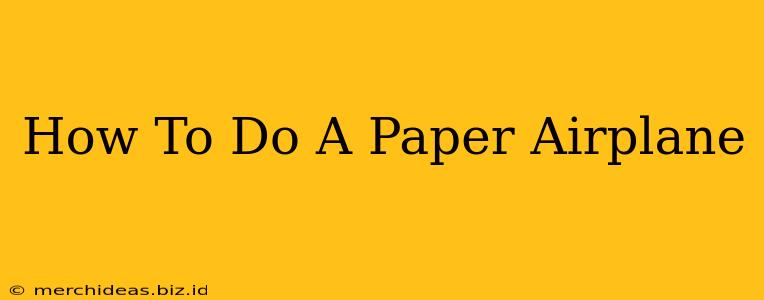So, you want to make a paper airplane? Not just any paper airplane, but one that soars gracefully through the air, defying gravity with its aerodynamic prowess? You've come to the right place! This guide will walk you through creating a classic dart-style paper airplane, guaranteed to impress your friends (and maybe even yourself). We'll cover the steps, offer some pro tips, and even explore how to customize your design for optimal flight.
Step-by-Step Instructions: The Classic Dart
This method creates a simple yet effective paper airplane design that's perfect for beginners.
What you'll need:
- One sheet of standard printer paper (8.5 x 11 inches or A4)
Let's get started!
-
Fold in Half: Begin by folding your paper in half lengthwise, creasing sharply. Then unfold it. This creates a center crease that will be your guide throughout the process.
-
Fold the Top Corners: Fold each top corner down to meet the center crease. Make sure the edges align perfectly. Crease well.
-
Fold Down the Top Flaps: Now, fold the top flaps (the triangles you just created) down again, but this time towards the bottom edge of the paper. Crease firmly.
-
Fold in Half (Again!): Fold the entire plane in half along the original center crease, with the flaps on the inside. Crease firmly. This is where the shape of your airplane really takes form.
-
Fold the Wings: This is the crucial step! Fold each wing down along the edges of the paper. The angle of this fold will influence the flight characteristics of your airplane. Experiment! A sharper angle will result in a faster, more agile flight, while a more gradual angle will give you a longer, more gliding flight.
-
Adjust the Wings (Optional): Once the wings are folded, you might want to subtly adjust their angle upward. This helps to increase lift and stability during flight.
Pro Tips for a Superior Flight
- Paper Type: While standard printer paper works fine, experimenting with different weights and types of paper can significantly affect flight performance. Thicker paper might result in a more stable, though potentially slower, flight.
- Creases: Crisp, sharp creases are essential. The sharper the creases, the more aerodynamically efficient your airplane will be.
- Throwing Technique: The way you throw the airplane matters just as much as its construction. Hold the airplane horizontally, just behind the wings. Throw with a smooth, overhand motion, using your whole arm for a powerful, yet controlled throw. Practice makes perfect!
- Experimentation: Don't be afraid to experiment! Try varying the wing angles, adding small folds or adjustments, and see how it affects your airplane's flight path. The best paper airplane is the one you design.
Beyond the Basics: Exploring Different Designs
Once you've mastered the classic dart, there’s a whole world of paper airplane designs to explore! From simple variations to incredibly complex models, there’s something for every skill level. Search online for "paper airplane designs" to discover a universe of flying creations waiting to take to the skies.
Conclusion: Let Your Imagination Take Flight!
Making a paper airplane is more than just a childhood pastime. It’s a fun, creative activity that combines engineering, physics, and a healthy dose of imaginative play. So grab a sheet of paper, follow the steps, and let your imagination take flight! Happy flying!
